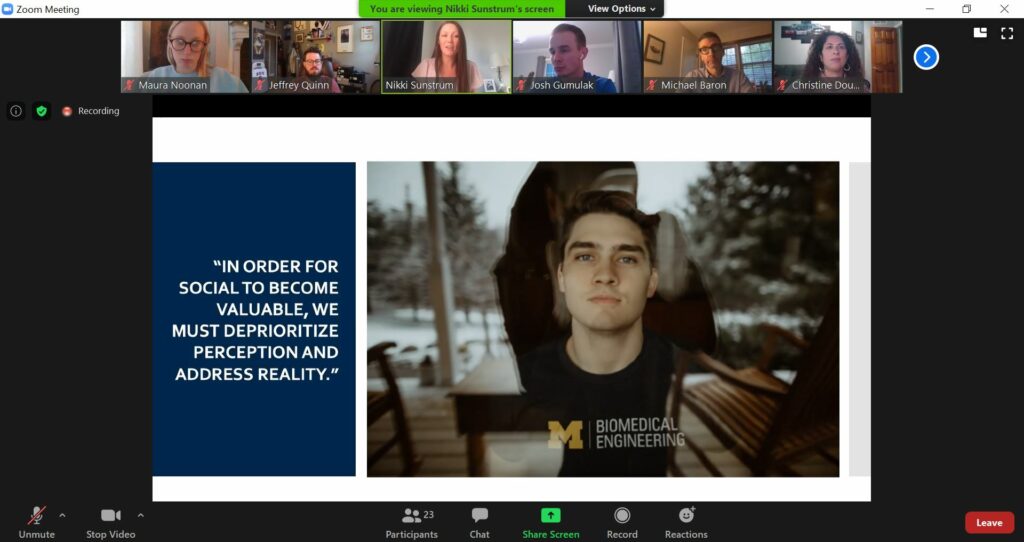Post by Emily Burns Perryman originally on BizJournals.com
I firmly believe that individuals in all fields and industries should be continually learning and evolving as professionals throughout all points of their career. From college intern to C-level executive, continued professional development through education and new experiences help add to your skill set, understand how different areas of business and industry work together, and can often uncover beneficial new perspectives.
However, it’s not just the individual who should be concerned about ongoing professional development. It’s important for the decision makers and senior leadership within businesses and organizations to place value on new skills and knowledge, offer and encourage training when their resources allow, and recognize that well trained and motivated employees can help meet their most important business goals and objectives. Some of these objectives may include building community and public relations, increasing lead generation and sales, and building brand awareness.
As many are aware, the skills and knowledge attained for both personal development and career advancement can often be achieved through mentoring situations. This one-on-one process generally involves an individual with finely tuned skills or experience, who can provide career advice, direction and guidance to someone at a more junior level. You may be familiar with or have taken part in mentor situations, but consider that often times “reverse mentoring” can be helpful and beneficial as well… especially in the ever evolving web and social media spaces.
Mentors in the workplace used to be a generation or two older and more seasoned than their charges. That model isn’t the only one these days. Many companies have put forth an effort or created internal programs to educate senior executives in the areas of workplace trends, technology and social media. Upper level employees are paired up with or study under younger employees in a trend known as reverse mentoring, which has become popular within a wide range of industries.
According to a 2011 article in The Wall Street Journal, chief executive of General Electric Co. Jack Welch firmly advocated for reverse mentoring, and ordered 500 top-level executives to reach out to subordinates to learn how to use the web. He saw the value in new skills and experience, and wanted his employees to connect and share their knowledge in an important space.
It’s well recognized that frequently young mentors can provide valuable insight on navigating the complexities of various social media platforms, all of which have become essential for business communication, but often overwhelming to older generations. With globalization, technology and access to data shifting and evolving so rapidly, older generations are increasingly identifying the need to catch up and study how to use new web tools and techniques.
With many employees in the Gen X and Gen Y (also known as the Millennial generation) demographics more familiar with and skillful in regard to social media and web tools, they have unique expertise and skills of value to share with their more seasoned coworkers. Reverse mentoring can also help younger employees become more comfortable within a company or organization, promoting trust and cooperation.
In my experience, reverse mentoring situations and social media training must be part of a company’s corporate culture. From top down it must be communicated and reinforced that social media skills are incredibly useful in the business space, and that reverse mentoring opportunities, internal and external social media and web training are all vital to an employees’ success. Reinforcing the importance of these skills can help motivate employees, and placing team members side by side to work together can help champion effective communication.
My firm leadership shares the philosophy that reverse mentoring is important.
“When you have talent in an organization with a passion and a vision, trusting these people and empowering them is an essential ingredient in creating success,” says Ronald J. Soluri Sr., our managing director. “Freed Maxick has always been successful when allowing talent the opportunity to champion new ideas and areas of practice development. Social media is a growing and a diverse area with many channels to reach people, but having content that is relevant is a challenge. Here we are fortunate to have young professionals like Emily pushing this area and enlisting more disciples every day. We have also chosen to invest more in this area, and have recently added a content writer to help manage a steady flow of quality content for our social channels.”
Although your company or organization may not offer reverse mentoring opportunities yet, there are some local groups that may be able to assist. Social Media Club Buffalo is the local chapter of a national group designed to host conversations that explore key issues facing society as technologies transform. The club offers members networking opportunities and thoughtfully designed programs and special events to educate attendees about the world of social media. Check their schedule, get involved, and you may find some talented local professionals who can help reverse mentor you or your team.
Another skillful group is The Advertising Club of Buffalo. With mobile penetration rates rising across the globe, and social media’s exponential growth, marketers are increasingly viewing paid social media advertising as an integrated part of their strategy. Advertising professionals must be skilled in all creative approaches, from print, to outdoor, to online.
When I recently touched base with my contact there, I discovered that organizers are eager to explore the creation of reverse mentoring programs, special events and educational opportunities in the near future. They understand the value that this new mentoring relationship model can bring to the table, especially in the area of the web and social media, and are working to create new opportunities for their members.
The qualities of a great leader can be found in many individuals. Remember that social media is a powerful tool within business, and reverse mentoring can help educate those who need a bit of help and guidance. It may appear overwhelming, but the sharing of a few simple best practices, a review of which social platforms work best for different purposes, and a little inter-generational teamwork can go a long way, helping meet many of the most important business objectives.
Emily Burns Perryman is a State University of New York Fashion Institute of Technology graduate and started her career in New York City working for fashion and digital media companies. She is currently e-Marketing Communications Specialist for regional accounting firm Freed Maxick CPAs. Follow them on Twitter @FreedMaxickCPAs.
 The prominence of social media has not only altered the way in which we communicate personally, it has reshaped the information we consume, distorted emotional responses, and manipulated the visual identities of its users. In an ever-connected world, everyone struggles to balance competing priorities, remain engaged, and retain authenticity.
The prominence of social media has not only altered the way in which we communicate personally, it has reshaped the information we consume, distorted emotional responses, and manipulated the visual identities of its users. In an ever-connected world, everyone struggles to balance competing priorities, remain engaged, and retain authenticity.

